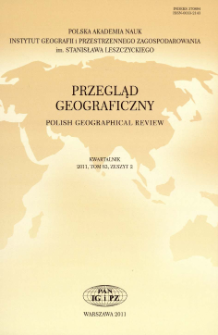
Object
Title: O próbie zastosowania teorii chaosu do opisu ewolucji obszaru turystycznego = On an attempt at applying chaos theory in describing the evolution of a tourism area
Subtitle:
Przegląd Geograficzny T. 83 z. 2 (2011)
Publisher:
Place of publishing:
Description:
Type of object:
References:
1. Agarwal S., 1997, The resort cycle and seaside tourism: An assessment of its applicability and validity, Tourism Management, 18, 1, s. 65–73.
2. Bertalanffy von L., 1951, An outline of general system theory, British Journal of the Philosophy of Science, 1, s. 134–165.
3. Bertalanffy von L., 1984, Ogólna teoria systemów. Podstawy, rozwój, zastosowania, PWN, Warszawa.
4. Butler R.W., 1980, The concept of a tourism area cycle of evolution: implications for the management of resources, Canadian Geographer, 24, 1, s. 5–12.
5. Butler R.W., 2006a, The Tourism Area Life Cycle – Applications and Modifications, Channel View Publications, Clevedon.
6. Butler R.W., 2006b, The Tourism Area Life Cycle – Conceptual and Theoretical Issues, Channel View Publications, Clevedon.
7. Chojnicki Z., 1988, Koncepcja terytorialnego systemu społecznego, Przegląd Geograficzny, 60, 4, s. 491–510.
8. Cooper C., Jackson S., 1989, Destination lifecycle: the Isle of Man case study, Annals of Tourism Research, 16, 2, s. 377–398.
9. Douglas N., 1997, Applying the lifecycle model to Melanesia, Annals of Tourism Research, 24, 1, s. 1–22.
10. Farrell B., Twinning-Ward L., 2005, Seven steps towards sustainability: Tourism in the context of new knowledge, Journal of Sustainable Tourism, 13, 1, s. 109–122.
11. Hovinen G., 2001, Revisiting the destination lifecycle model, Annals of Tourism Research, 29, s. 209–230.
12. Kruczek Z., Zmyślony P., 2010, Regiony turystyczne, Proksenia, Kraków.
13. Liszewski S., Baczwarow M., 1998, Istota i właściwości przestrzeni rekreacyjno-turystycznej, Turyzm, 8, 1, s. 39–67.
14. Lundtorp S., Wanhill S., 2001, The resort lifecycle theory, Annals of Tourism Research, 29, 4, s. 947–964.
15. McDonald J. R., 2009, Complexity science: an alternative world view for understanding sustainable tourism development, Journal of Sustainable Tourism, 17, 3, s. 455–471.
16. Mc Kercher B., 1999, A chaos approach to tourism, Tourism Management, 20, 4, s. 425–434.
17. Oppermann M., 1998, What is new with the resort cycle?, Tourism Management, 19, 1, s. 169–180.
18. Prigogine L., Stengers R., 1985, Order out of Chaos. Man’s New Dialogue with Nature, Flamingo, London.
19. Russell R, Faulkner B., 1999, Movers and shakers: Chaos makers in tourism development, Tourism Management, 20, 4, s. 411–423.
20. Russell R, Faulkner B., 2004, Enterpreneurship, chaos and the tourism area lifecycle, Annals of Tourism Research, 31, 3, s. 556–579.
21. Szulc-Dąbrowiecka E., 2004, Farafra jako miejscowość turystyczna w latach 1993–2004, Afryka, Azja, Ameryka Łacińska, 81, s. 157–185.
22. Tempczyk M., 1998, Teoria chaosu a filozofia, Wydawnictwo Cis, Warszawa.
Relation:
Volume:
Issue:
Start page:
End page:
Detailed Resource Type:
Format:
File size 0,5 MB ; application/pdf
Resource Identifier:
oai:rcin.org.pl:1846 ; 0033-2143 ; 10.7163/PrzG.2011.2.2
Source:
CBGiOS. IGiPZ PAN, call nos.: Cz.181, Cz.3136, Cz.4187 ; click here to follow the link
Language:
Language of abstract:
Rights:
Terms of use:
Copyright-protected material. May be used within the limits of statutory user freedoms
Digitizing institution:
Institute of Geography and Spatial Organization of the Polish Academy of Sciences
Original in:
Projects co-financed by:
Programme Innovative Economy, 2010-2014, Priority Axis 2. R&D infrastructure ; European Union. European Regional Development Fund
Access:
Object collections:
- Institute of Geography and Spatial Organization PAS (IGiPZ PAN) > Publications of IGiPZ PAN and employees
- Institute of Geography and Spatial Organization PAS (IGiPZ PAN) > Library > Series/Journals/Periodics
Last modified:
Oct 2, 2020
In our library since:
Jan 17, 2012
Number of object content downloads / hits:
2541
All available object's versions:
https://rcin.org.pl/igipz/publication/12790
Show description in RDF format:
Show description in RDFa format:
Show description in OAI-PMH format:
| Edition name | Date |
|---|---|
| Mazurkiewicz L. - O próbie zastosowania teorii chaosu do opisu ewolucji obszaru turystycznego | Oct 2, 2020 |
Objects Similar
Mazurkiewicz, Ludwik
Mazurkiewicz, Ludwik

 INSTYTUT ARCHEOLOGII I ETNOLOGII POLSKIEJ AKADEMII NAUK
INSTYTUT ARCHEOLOGII I ETNOLOGII POLSKIEJ AKADEMII NAUK
 INSTYTUT BADAŃ LITERACKICH POLSKIEJ AKADEMII NAUK
INSTYTUT BADAŃ LITERACKICH POLSKIEJ AKADEMII NAUK
 INSTYTUT BADAWCZY LEŚNICTWA
INSTYTUT BADAWCZY LEŚNICTWA
 INSTYTUT BIOLOGII DOŚWIADCZALNEJ IM. MARCELEGO NENCKIEGO POLSKIEJ AKADEMII NAUK
INSTYTUT BIOLOGII DOŚWIADCZALNEJ IM. MARCELEGO NENCKIEGO POLSKIEJ AKADEMII NAUK
 INSTYTUT BIOLOGII SSAKÓW POLSKIEJ AKADEMII NAUK
INSTYTUT BIOLOGII SSAKÓW POLSKIEJ AKADEMII NAUK
 INSTYTUT CHEMII FIZYCZNEJ PAN
INSTYTUT CHEMII FIZYCZNEJ PAN
 INSTYTUT CHEMII ORGANICZNEJ PAN
INSTYTUT CHEMII ORGANICZNEJ PAN
 INSTYTUT FILOZOFII I SOCJOLOGII PAN
INSTYTUT FILOZOFII I SOCJOLOGII PAN
 INSTYTUT GEOGRAFII I PRZESTRZENNEGO ZAGOSPODAROWANIA PAN
INSTYTUT GEOGRAFII I PRZESTRZENNEGO ZAGOSPODAROWANIA PAN
 INSTYTUT HISTORII im. TADEUSZA MANTEUFFLA POLSKIEJ AKADEMII NAUK
INSTYTUT HISTORII im. TADEUSZA MANTEUFFLA POLSKIEJ AKADEMII NAUK
 INSTYTUT JĘZYKA POLSKIEGO POLSKIEJ AKADEMII NAUK
INSTYTUT JĘZYKA POLSKIEGO POLSKIEJ AKADEMII NAUK
 INSTYTUT MATEMATYCZNY PAN
INSTYTUT MATEMATYCZNY PAN
 INSTYTUT MEDYCYNY DOŚWIADCZALNEJ I KLINICZNEJ IM.MIROSŁAWA MOSSAKOWSKIEGO POLSKIEJ AKADEMII NAUK
INSTYTUT MEDYCYNY DOŚWIADCZALNEJ I KLINICZNEJ IM.MIROSŁAWA MOSSAKOWSKIEGO POLSKIEJ AKADEMII NAUK
 INSTYTUT PODSTAWOWYCH PROBLEMÓW TECHNIKI PAN
INSTYTUT PODSTAWOWYCH PROBLEMÓW TECHNIKI PAN
 INSTYTUT SLAWISTYKI PAN
INSTYTUT SLAWISTYKI PAN
 SIEĆ BADAWCZA ŁUKASIEWICZ - INSTYTUT TECHNOLOGII MATERIAŁÓW ELEKTRONICZNYCH
SIEĆ BADAWCZA ŁUKASIEWICZ - INSTYTUT TECHNOLOGII MATERIAŁÓW ELEKTRONICZNYCH
 MUZEUM I INSTYTUT ZOOLOGII POLSKIEJ AKADEMII NAUK
MUZEUM I INSTYTUT ZOOLOGII POLSKIEJ AKADEMII NAUK
 INSTYTUT BADAŃ SYSTEMOWYCH PAN
INSTYTUT BADAŃ SYSTEMOWYCH PAN
 INSTYTUT BOTANIKI IM. WŁADYSŁAWA SZAFERA POLSKIEJ AKADEMII NAUK
INSTYTUT BOTANIKI IM. WŁADYSŁAWA SZAFERA POLSKIEJ AKADEMII NAUK
































